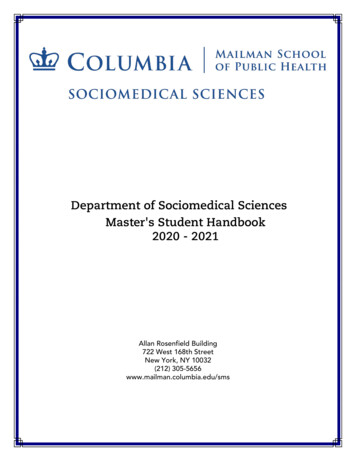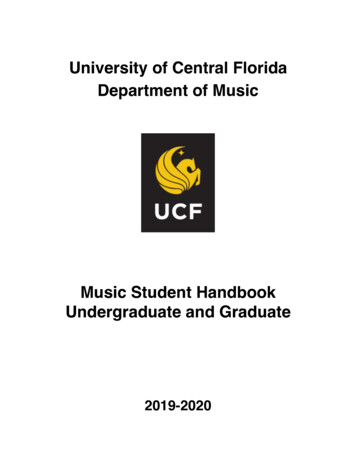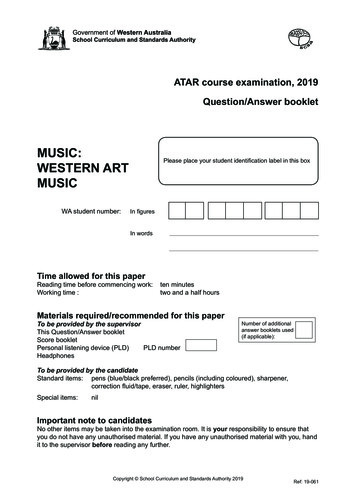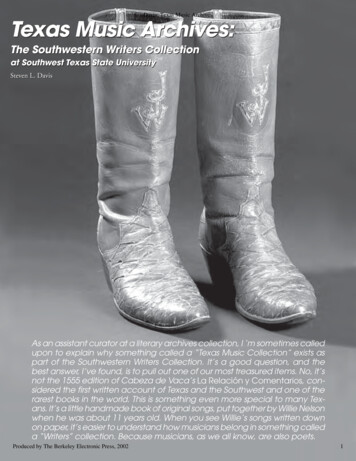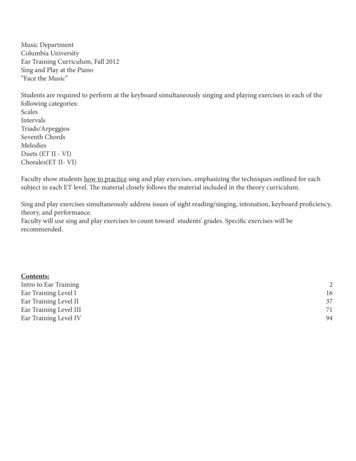
Transcription
Music DepartmentColumbia UniversityEar Training Curriculum, Fall 2012Sing and Play at the Piano“Face the Music”Students are required to perform at the keyboard simultaneously singing and playing exercises in each of thefollowing categories:ScalesIntervalsTriads/ArpeggiosSeventh ChordsMelodiesDuets (ET II - VI)Chorales(ET II- VI)Faculty show students how to practice sing and play exercises, emphasizing the techniques outlined for eachsubject in each ET level. The material closely follows the material included in the theory curriculum.Sing and play exercises simultaneously address issues of sight reading/singing, intonation, keyboard proficiency,theory, and performance.Faculty will use sing and play exercises to count toward students’ grades. Specific exercises will berecommended.Contents:Intro to Ear TrainingEar Training Level IEar Training Level IIEar Training Level IIIEar Training Level IV216377194
“Face the Music”2Introduction to Ear Training“Sing and Play”ScalesMajorNatural/Harmonic/Melodic MinorIn Unison, Harmonized CanonicallyHarmonized in Thirds and SixthsLower and Upper Tetra-Chord ‘White-Note’ Scalespp. 3-7IntervalsSing and Play Technique for Intervals ISing and Play Technique for Intervals IIpp. 8-11Triads/ArpeggiosSing and Play Technique for TriadsSing and Play Technique for Arpeggiospp. 12-14MelodyUnmetered Melodiesp.15
Introduction to Ear Training“Face the Music”- ScalesScalesPlay all major and minor scales up and down, and sing simultaneously using solfegePlay with right hand, singPlay with left hand, singScales and ExercisesPlay with both hands, singScorePiano fingerings are preferred, but not required. [Subtitle]Scales and ExercisesScales cales and . coreLH54321515[Subtitle]12312Sol3La4Ti5DoLH olLaTiDoDoReMiFaSolLaTiDoSolLaTiDo3DoReMiFa3. eMiFaSolLaTiDoDoReMiFaSolLaTiDoDoReMiFa4. aTiDoDoReMiFaSolLaTiDoDoReMiFaSolLaTiDo3
Introduction to Ear Training5.“Face the Music”- Scales4Ear Training "Sing and Play"Play first, then sing.SingReMiFa "SingSol and LaEarTrainingPlay"TiDoDoPlay6Ear Training "Sing and Play"SingSingSingDoDoDo6.Ti yPlaySing first, then play.SingSingSingMajorDoRePlayPlayPlayNatural MinorSingMajorSingSingPlayPlayPlayHarmonic ic MinorMiFaSolLaTiDoetc.
Introduction to Ear TrainingSingDo“Face the Music”- ScalesReHarmonized Vocal ScalesMiFaSol5LaTiDoPlayPlayfrom tonic, sing from tonic when scale reaches 3rd scale degreeFirst right hand plays, then left hand, then both hands together6Ear Training "Sing and Play"MajorSing7.DoPlaySingSing8.PlayPlayNatural MinorSingSing9.PlayPlayHarmonic MinorSing10.PlayMelodic MinorSing11.PlayTiLaSolFaMiReDo
Introduction to Ear Training“Face the Music”- Scales6PlaySing and play overlapping scales. Note the different interval relationships that result in the ascending and descending direction.2Ear Training "Sing and Play"SingSing12.PlayPlaySingSing13.PlayPlayPlay the scale, sing a third abovePlay the scale, sing a sixth yFragmentsPlayetc.
Introduction to Ear Training16. Tetrachords“Face the Music”- ScalesIntro ET #16Play then SingSing then PlayIntro ET #16Play then SingUse the same process for the “white-note” scales.Play then Sing, ascendingPlay then Sing, descendingSing then Play, ascendingSing then Play, descendingSwitch Right Hand, Left Hand, Both HandsPlay every note and singPlay every other note and singPlay fewer and fewer notes until singing a capellaSing then Play7
Introduction to Ear Training“Face the Music”- Intervals17. Sing and Play Technique for Intervals8Susser
Play 4Introduction to Ear Training“Face the Music”- Intervals9Sing and PlayTechnique for Intervals II18. SecondsSusserSingPlay 1Play 2Play 3Play 419. ThirdsSingPlay 1Play 2Play 3Play 4SingPlay 1Play 2Play 3SingIntro to ET sing and Play3
Play 2Introduction to Ear Training“Face the Music”- Intervals10Play 320. FourthsSingPlay 1Play 2Play 34Intro to ET sing and PlaySingPlay 1Play 2Play 3SingPractice the following in a similar manner, reducing and altering what you play.PianoScore21. FifthsPianoSingPlay 1SingPlay 2PlaySing3Play 4SingSingIntro ET #16[Subtitle][Composer][Arranger]
SingSingIntroduction to Ear Training“Face the Music”- IntervalsSingSing 3.Sing ng24.OctavesSingSingSing Sing2Intro ET #16 SingSing11
Introduction to Ear Training“Face the Music”- Triads12Scale technique for Triads- Intro ETScore Technique for Triads25. dSingPlayAugmented*SingPlay*Note the use of f#SingPlay [Composer][Arranger]
Introduction to Ear Training“Face the Music”- Arpeggios1326. Sing and Play Technique for ArpeggiosPlay and sing as directed.Major 2SusserEar Training "Sing and Play"SingPlaySingPlayEar Training "Sing and ySingPlaySingPlayPlayPlaySingFragmentsPlayetc.
SingIntroduction toEar TrainingPlay“FaceSing the Music”- ArpeggiosPlayPlay27. ArpeggioPlayPlayarpeggios in Major and Minor, singing in unison, and in harmony with the ng14
Introduction to Ear TrainingScore28. Unmetered Melodies“Face the Music”- MelodiesIntro ET #28[Subtitle]See Instructions Below1.2.3.Sing and play each measure separately.Switch right hand, left hand, both handsPlay every note and singPlay every other note and singPlay fewer and fewer notes until singing all four notes a capella 15Susser[Composer][Arranger]
Introduction to Ear Training “Face the Music”- Scales 3 Scales Play all major and minor scales up and down, and sing simultaneously using solfege Play with right hand, sing Play with le# hand, sing Play with both hands, sing Piano "ngerings are preferred, but not required. T 1 T5 Do RH LH T 2 T4 Re T 3 T3 Mi T 1 T2 Fa T 2 T1 Sol T 3 T 3 La T 4 T2 Ti T 5 T 1 Do T T T T T T T T T T TT T T T T T




